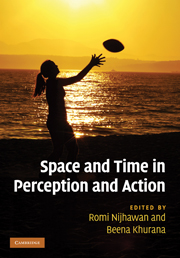Book contents
- Frontmatter
- Contents
- List of contributors
- Acknowledgments
- 1 Space and time: the fabric of thought and reality
- Part I Time–space during action: perisaccadic mislocalization and reaching
- 2 The internal eye position signal, psychophysics, and neurobiology
- 3 Factors influencing perisaccadic visual mislocalization
- 4 Visual and nonvisual factors in perisaccadic compression of space
- 5 Keeping vision stable: rapid updating of spatiotopic receptive fields may cause relativistic-like effects
- 6 Combined influences of extraretinal signals, retinal signals, and visual induction on space perception and manual behavior in perisaccadic and steady viewing
- 7 Space constancy: the rise and fall of perceptual compensation
- 8 Intercepting moving objects: do eye movements matter?
- 9 The utility of visual motion for goal-directed reaching
- Part II Temporal phenomena: perception
- Part III Temporal phenomena: binding and asynchrony
- Part IV Spatial phenomena: forward shift effects
- Part V Space–time and awareness
- Index
- References
5 - Keeping vision stable: rapid updating of spatiotopic receptive fields may cause relativistic-like effects
from Part I - Time–space during action: perisaccadic mislocalization and reaching
Published online by Cambridge University Press: 05 October 2010
- Frontmatter
- Contents
- List of contributors
- Acknowledgments
- 1 Space and time: the fabric of thought and reality
- Part I Time–space during action: perisaccadic mislocalization and reaching
- 2 The internal eye position signal, psychophysics, and neurobiology
- 3 Factors influencing perisaccadic visual mislocalization
- 4 Visual and nonvisual factors in perisaccadic compression of space
- 5 Keeping vision stable: rapid updating of spatiotopic receptive fields may cause relativistic-like effects
- 6 Combined influences of extraretinal signals, retinal signals, and visual induction on space perception and manual behavior in perisaccadic and steady viewing
- 7 Space constancy: the rise and fall of perceptual compensation
- 8 Intercepting moving objects: do eye movements matter?
- 9 The utility of visual motion for goal-directed reaching
- Part II Temporal phenomena: perception
- Part III Temporal phenomena: binding and asynchrony
- Part IV Spatial phenomena: forward shift effects
- Part V Space–time and awareness
- Index
- References
Summary
Summary
People shift their gaze more frequently than they realize, sometimes smoothly to track objects in motion, more often abruptly with a saccade to bring a new part of the visual field under closer visual examination. Saccades are typically made three times a second throughout most of our waking life, but they are rarely noticed. Yet they are accompanied by substantial changes in visual function, most notably suppression of visual sensitivity, mislocalization of spatial position, and misjudgments of temporal duration and order of stimuli presented around the time. Here we review briefly these effects and expound a novel theory of their cause. To preserve visual stability, receptive fields undergo a fast but not instantaneous remapping at the time of saccades. If the speed of remapping approaches the physical limit of neural information transfer, it may lead to relativistic-like effects observed psychophysically, namely a compression of spatial relationships and a dilation of time.
Introduction
Saccades are ballistic movements of the eyes made to reposition our gaze. They can be deliberate but normally are automatic and go unnoticed. Not only do the actual eye movements escape notice, but so do the image motion they cause and the fact that gaze itself has been repositioned. This problem has gained the attention of most visual scientists, including von Helmholtz (1866), Sperry (1950), Alhazen (1083), and Howard (1996). A general conclusion to emerge from a variety of studies was that saccades were accompanied by a “corollary discharge” (Sperry 1950) or an “efference copy” (von Holst & Mittelstädt 1954) of the motor signal that corrected for the eye movement (for general review, see Ross et al. 2001).
- Type
- Chapter
- Information
- Space and Time in Perception and Action , pp. 52 - 62Publisher: Cambridge University PressPrint publication year: 2010
References
- 3
- Cited by

